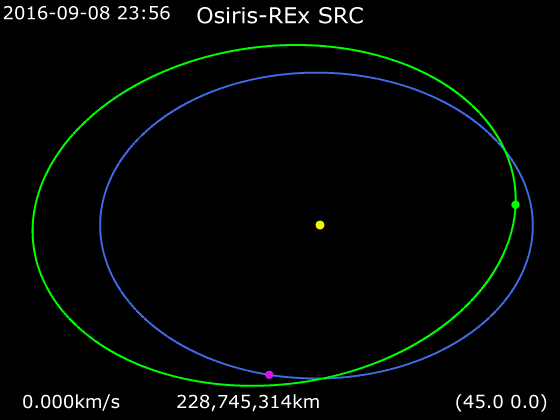neufer wrote: ↑Wed Nov 14, 2018 2:46 pm
Chris Peterson wrote: ↑Wed Nov 14, 2018 1:14 pmBDanielMayfield wrote: ↑Tue Nov 13, 2018 10:18 pm
Better not bump it too hard... Imagine the liability if it was accidentally pushed into an Earth intersecting orbit... The ultimate butterfly effect.
Of course, the tiniest bump could as easily prevent a collision with Earth. That's the thing about chaos theory. No way to tell.
https://en.wikipedia.org/wiki/101955_Bennu wrote:
- Bennu will pass 0.005au from Earth on 23 September 2060. The close approach of 2060 causes divergence in the close approach of 2135.
2. On 25 September 2135 the nominal approach distance is 0.002au from Earth, but Bennu could pass as close as 0.0007au.
(There is no chance of an Earth impact in 2135.)
3. The 2135 approach will create many lines of variations and Bennu may pass through a gravitational keyhole during the 2135 passage which could create an impact scenario at a future encounter. The keyholes are all less than 55 km wide.
In order to move Bennu by
~0.001au before its next encounter with Earth Bennu's velocity must be sped up or slowed down by ~11 cm/sec.
This would require a momentum impulse of ~7,500,000,000 kg m/sec.
The Paris Gun used to bombard Paris during World War I generated a momentum impulse of ~175,000 kg m/sec.
Hence, a Bennu/Paris Gun would have to discharge over 40,000 times to have a significant effect
for the near future.
I just stumbled upon the site:
https://cneos.jpl.nasa.gov/ which I find really wonderful. They have a nice set of data and you can run the data in animations for many near-earth objects. I could learn a lot from that site, if I were to give it the time it deserves. What I did learn is that 101955 Bennu has an elliptical orbit similar to Musk's roadster -- running from just a little inside Earth's orbit to nearly Mars' orbit. But I don't think it ever has close encounters with Mars, it is probably not in Mars' orbital plane when it approaches. It can get arbitrarily close to Earth, crossing our orbit, and the close encounters should be about once every 6 years or so.
Back to your momentum calculation. I'll gladly accept that you did the math to determine that it would take an impulse of about 7.5x10
9 Ns to slow Bennu enough to displace it by 0.001 AU. I assume you figured this displacement in a period that would be about 5 orbits for Bennu = 6 orbits for Earth. (?) And that much displacement ought to be enough to avoid an encounter. The first stage of the Saturn V, I believe, could deliver 9x10
9 Ns impulse, so that would mean we must have the capability, in theory, to give such a push with conventional tech.
Of course it is a lot easier to build and launch a Saturn V from Florida than to deliver a working Saturn V to an object in space, fully loaded with fuel. So this would require a lot more rockets and would beg a myriad of other questions as well.
(Examples: When would be the best time for such a mission. I assume it would be most efficient to try to intercept it at perigee #(n-1), if we wanted to push it with something between then and perigee #n? If we wanted to move such a pile of rubble, we might rather separate all of the engines of a Falcon-Heavy-like rocket and place them all in a large array. Build something more like a rocket-powered girdle. I wonder if nudging such an object out of our orbital plane is easier than nudging it backward or forward? It would seem a more permanent solution, upon first consideration. Then again, adjusting its perihelion to be > Earth's aphelion is another idea.
 Rotating Asteroid Bennu from OSIRIS-REx
Rotating Asteroid Bennu from OSIRIS-REx

